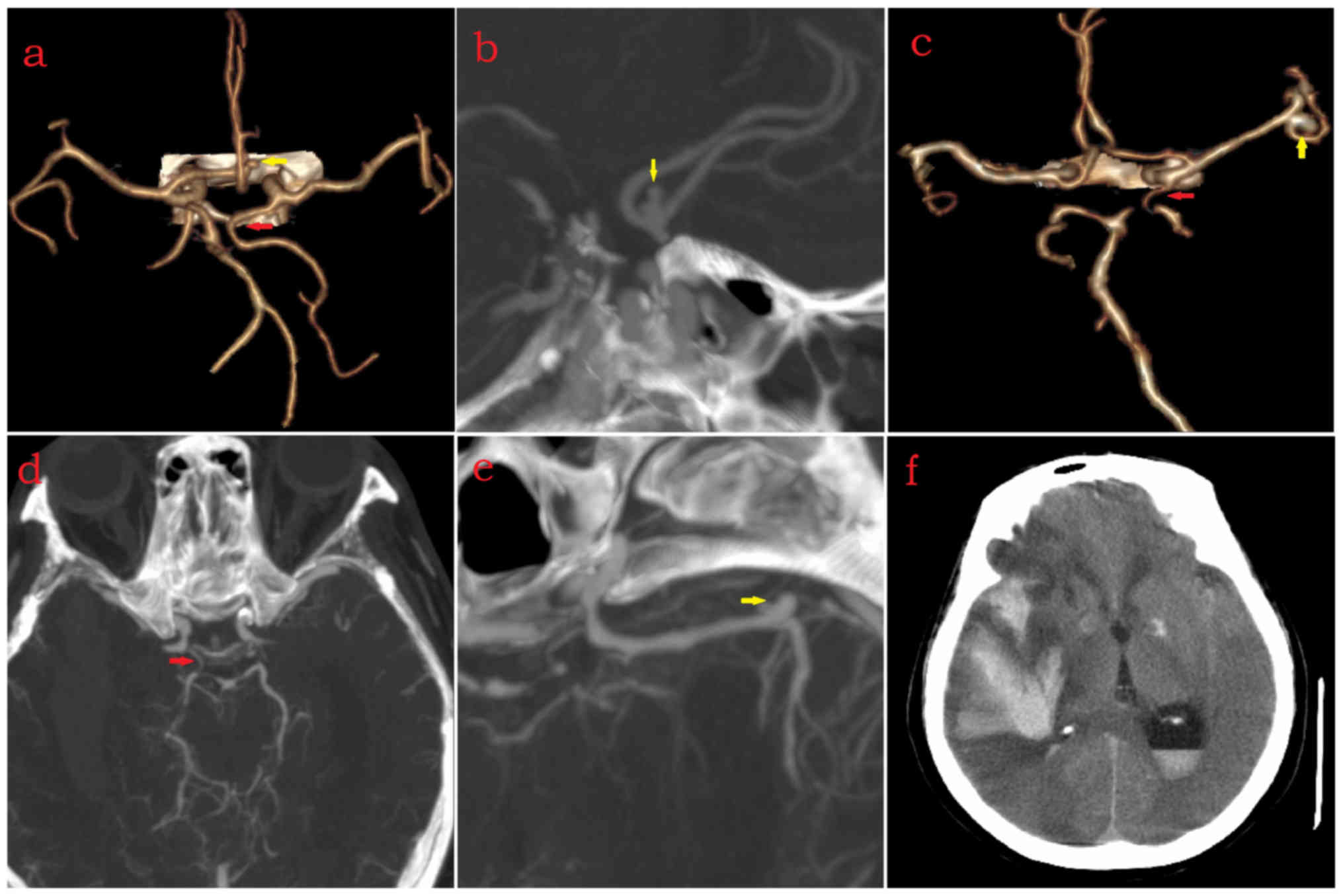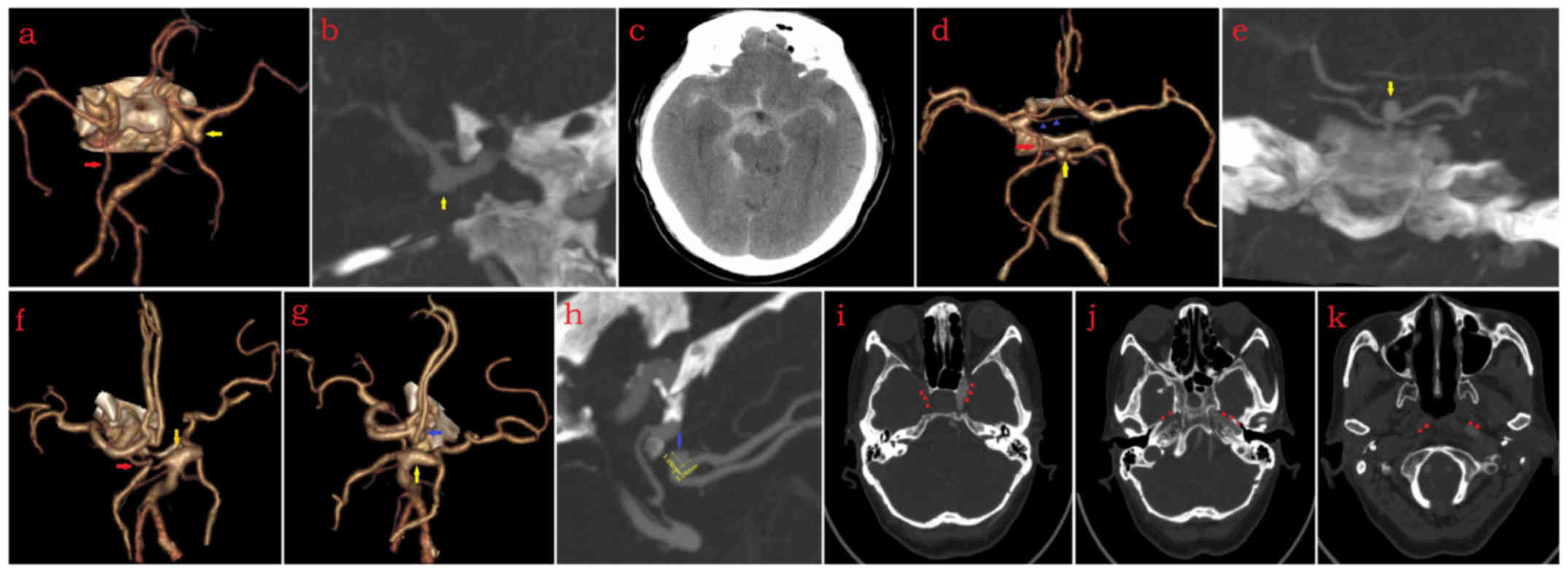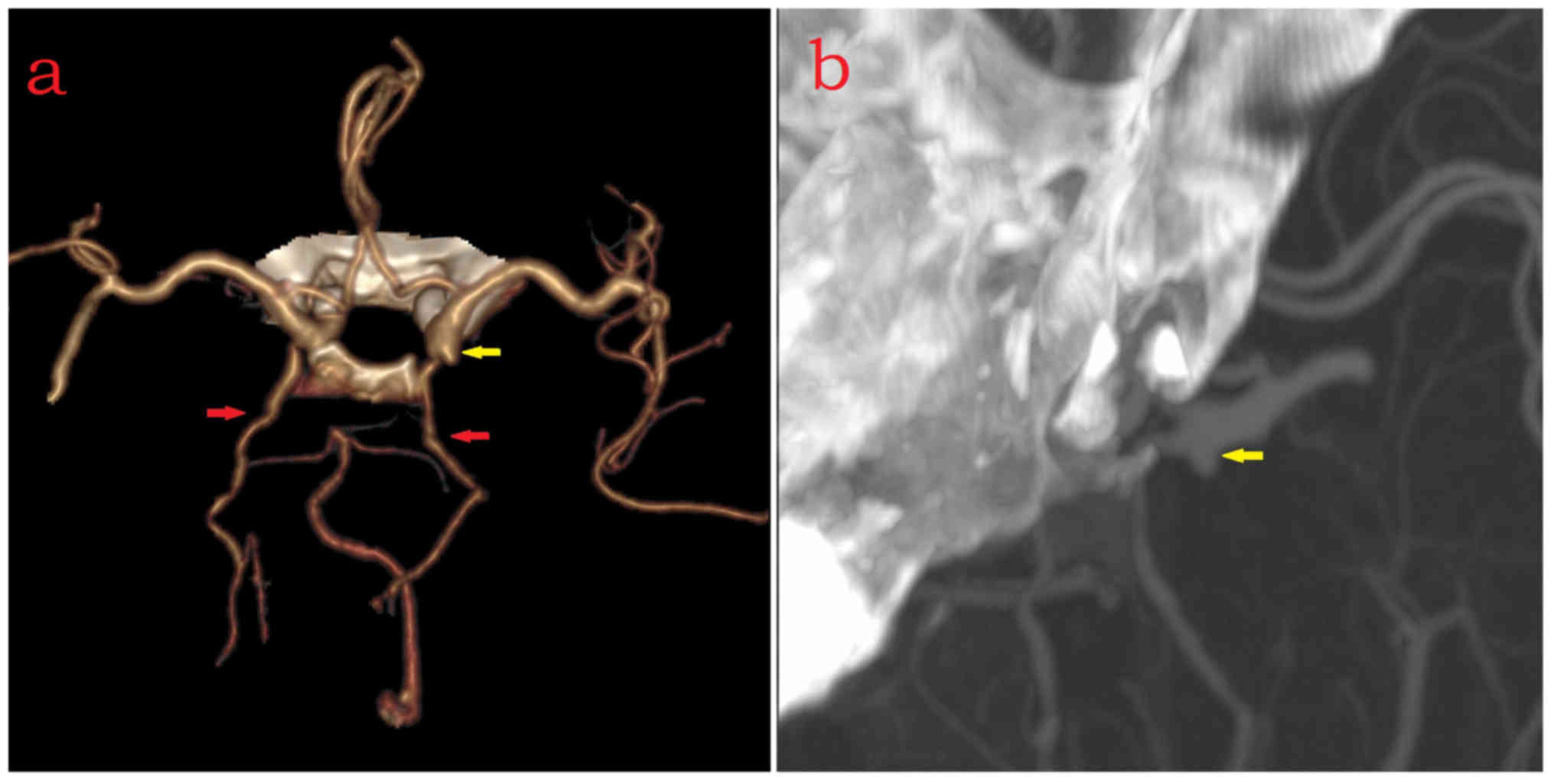|
1
|
Arjal RK, Zhu T and Zhou Y: The study of
fetal-type posterior cerebral circulation on multislice CT
angiography and its influence on cerebral ischemic strokes. Clin
Imaging. 38:221–225. 2014. View Article : Google Scholar : PubMed/NCBI
|
|
2
|
Lv X, Li Y, Yang X, Jiang C and Wu Z:
Potential proneness of fetal-type posterior cerebral artery to
vascular insufficiency in parent vessel occlusion of distal
posterior cerebral artery aneurysms. J Neurosurg. 117:284–287.
2012. View Article : Google Scholar : PubMed/NCBI
|
|
3
|
Alexandre AM, Visconti E, Schiarelli C,
Frassanito P and Pedicelli A: Bilateral internal carotid artery
segmental agenesis: Embryology, common collateral pathways,
clinical presentation and clinical importance of a rare condition.
World Neurosurg. 95:620.e9–620.e15. 2016. View Article : Google Scholar
|
|
4
|
Xu J, Xu L, Wu Z, Chen X, Yu J and Zhang
J: Fetal-type posterior cerebral artery: The pitfall of parent
artery occlusion for ruptured P2 segment and distal
aneurysms. J Neurosurg. 123:906–914. 2015. View Article : Google Scholar : PubMed/NCBI
|
|
5
|
Hu T and Wang D: Association between
anatomical variations of the posterior communicating artery and the
presence of aneurysms. Neurol Res. 1-7:2016.(Epub ahead of
print).
|
|
6
|
Tocco P, Fenzi F, Cerini R and Monaco S:
Adult-onset migraine-related ophthalmoplegia and omolateral
fetal-type posterior cerebral artery. BMJ Case Rep. 2011:pii:
bcr10201149302011. View Article : Google Scholar
|
|
7
|
Diogo MC, Fragata I, Dias SP, Nunes J,
Pamplona J and Reis J: Low prevalence of fetal-type posterior
cerebral artery in patients with basilar tip aneurysms. J
Neurointerv Surg. 9:698–701. 2017. View Article : Google Scholar : PubMed/NCBI
|
|
8
|
Kolukisa M, Gursoy AE, Kocaman G, Dürüyen
H, Toprak H and Asil T: Carotid endarterectomy in a patient with
posterior cerebral artery infarction: Influence of Fetal Type PCA
on atypical clinical course. Case Rep Neurol Med.
2015:1912022015.PubMed/NCBI
|
|
9
|
Lv N, Feng Z, Wang C, Cao W, Fang Y,
Karmonik C, Liu J and Huang Q: Morphological risk factors for
rupture of small (<7 mm) posterior communicating artery
aneurysms. World Neurosurg. 87:311–315. 2016. View Article : Google Scholar : PubMed/NCBI
|
|
10
|
Cron DC, Coleman DM, Sheetz KH, Englesbe
MJ and Waits SA: Aneurysms in abdominal organ transplant
recipients. J Vasc Surg. 59:594–598. 2014. View Article : Google Scholar : PubMed/NCBI
|
|
11
|
Huang DZ, Jiang B, He W, Wang YH and Wang
ZG: Risk factors for the recurrence of an intracranial saccular
aneurysm following endovascular treatment. Oncotarget.
8:33676–33682. 2017.PubMed/NCBI
|
|
12
|
González-Darder JM, Quilis-Quesada V,
Talamantes-Escribá F, Botella-Maciá L and Verdú-López F:
Microsurgical relations between internal carotid artery-posterior
communicating artery (ICA-PComA) segment aneurysms and skull base:
An anatomoclinical study. J Neurol Surg B Skull Base. 73:337–341.
2012. View Article : Google Scholar : PubMed/NCBI
|
|
13
|
Kim KM, Kang HS, Lee WJ, Cho YD, Kim JE
and Han MH: Clinical significance of the circle of Willis in
intracranial atherosclerotic stenosis. J Neurointerv Surg.
8:251–255. 2016. View Article : Google Scholar : PubMed/NCBI
|
|
14
|
Lochner P, Golaszewski S, Caleri F,
Ladurner G, Tezzon F, Zuccoli G and Nardone R: Posterior
circulation ischemia in patients with fetal-type circle of Willis
and hypoplastic vertebrobasilar system. Neurol Sci. 32:1143–1146.
2011. View Article : Google Scholar : PubMed/NCBI
|
|
15
|
Xu J, Yu Y, Wu X, Wu Y, Jiang C, Wang S,
Huang Q and Liu J: Morphological and hemodynamic analysis of mirror
posterior communicating artery aneurysms. PLoS One. 8:e554132013.
View Article : Google Scholar : PubMed/NCBI
|
|
16
|
Lin W, Ma X, Deng D and Li Y: Hemodynamics
in the circle of Willis with internal carotid artery stenosis under
cervical rotatory manipulation: A Finite element analysis. Med Sci
Monit. 21:1820–1826. 2015. View Article : Google Scholar : PubMed/NCBI
|
|
17
|
Law-Ye B, Geerts B, Galanaud D, Dormont D
and Pyatigorskaya N: Pseudo-asymmetry of cerebral blood flow in
arterial spin labeling caused by unilateral fetal-type circle of
Willis: Technical limitation or a way to better understanding
physiological variations of cerebral perfusion and improving
arterial spin labeling acquisition? J Cereb Blood Flow Metab 36:
1641–1643, 2016? J Cereb Blood Flow Metab 36: 1641–1643, 2016. 36:
1641–1643, 2016:1641-1643, 2016–1643, 2016. 2016.
|
|
18
|
Patel MA, Caplan JM, Yang W, Colby GP,
Coon AL, Tamargo RJ and Huang J: Arterial fenestrations and their
association with cerebral aneurysms. J Clin Neurosci. 21:2184–2188.
2014. View Article : Google Scholar : PubMed/NCBI
|
|
19
|
Orakdöğen M, Emon ST, Somay H, Engin T, Is
M and Hakan T: Vascular variations associated with intracranial
aneurysms. Turk Neurosurg. 27:853–862. 2017.PubMed/NCBI
|
|
20
|
Ilbay K, Ismailoglu O and Albayrak BS:
Co-existence of bilateral fetal type posterior cerebral artery and
the bilateral giant internal carotid artery aneurysms in an ataxic
patient. Eur J Radiol. 81:1388–1389. 2012. View Article : Google Scholar : PubMed/NCBI
|
|
21
|
Hao M, Ma J, Huang QJ, He SX, Liang Z and
Wang CB: Morphological parameters of digital subtraction
angiography 2D image in rupture risk profile of small intracranial
Aneurysms: A Pilot Study. J Neurol Surg A Cent Eur Neurosurg.
77:25–30. 2016. View Article : Google Scholar : PubMed/NCBI
|
|
22
|
Zada G, Breault J, Liu CY, Khalessi AA,
Larsen DW, Teitelbaum GP and Giannotta SL: Internal carotid artery
aneurysms occurring at the origin of fetal variant posterior
cerebral arteries: surgical and endovascular experience.
Neurosurgery. 63 1 Suppl 1:ONS55–ONS62. 2008.PubMed/NCBI
|
|
23
|
Harada K, Fukuyama K, Shirouzu T, Ichinose
M, Fujimura H, Kakumoto K and Yamanaga Y: Prevalence of unruptured
intracranial aneurysms in healthy asymptomatic Japanese adults:
Differences in gender and age. Acta Neurochir (Wien).
155:2037–2043. 2013. View Article : Google Scholar : PubMed/NCBI
|
|
24
|
Tada Y, Wada K, Shimada K, Makino H, Liang
EI, Murakami S, Kudo M, Shikata F, Pena Silva RA, Kitazato KT, et
al: Estrogen protects against intracranial aneurysm rupture in
ovariectomized mice. Hypertension. 63:1339–1344. 2014. View Article : Google Scholar : PubMed/NCBI
|
|
25
|
Brinjikji W, Zhu YQ, Lanzino G, Cloft HJ,
Murad MH, Wang Z and Kallmes DF: Risk factors for growth of
intracranial aneurysms: A systematic review and meta-analysis. AJNR
Am J Neuroradiol. 37:615–620. 2016. View Article : Google Scholar : PubMed/NCBI
|
|
26
|
Kang HG, Kim BJ, Lee J, Kim MJ, Kang DW,
Kim JS and Kwon SU: Risk factors associated with the presence of
unruptured intracranial aneurysms. Stroke. 46:3093–3098. 2015.
View Article : Google Scholar : PubMed/NCBI
|













